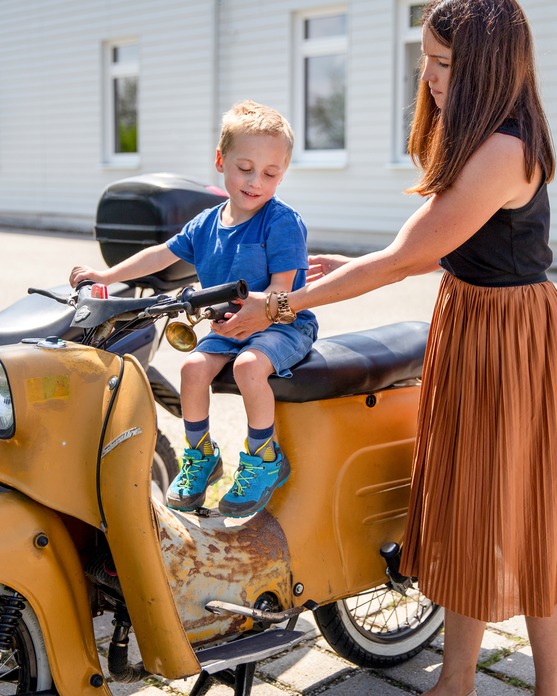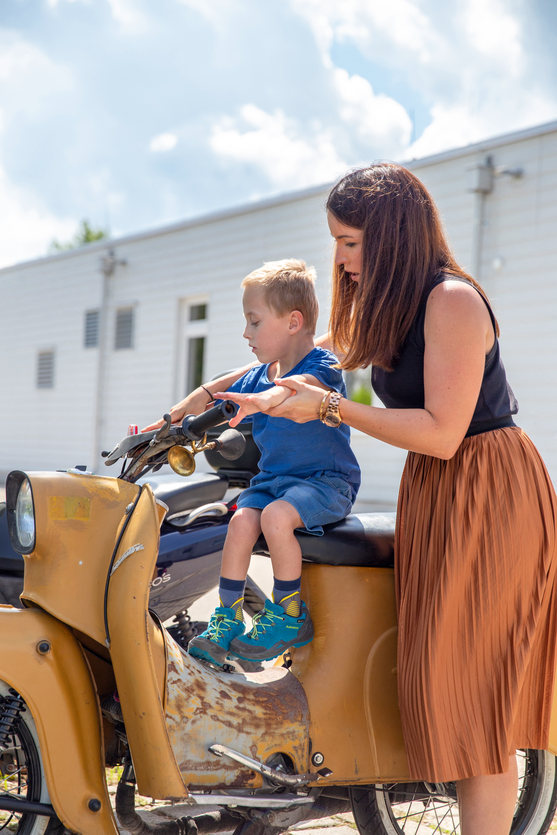Neurological disease
What exactly is infantile cerebral palsy?
Infantile cerebral palsy (also infantile paralysis and cerebral palsy, ICP, CP) describes a lifelong early childhood brain injury that can lead to disorders of posture, movement, coordination and balance. The ability to communicate, learn, eat and sleep can also be affected by this neurological disorder. The extent of the disorders depends on the location and size of the brain damage.
The term cerebral palsy is composed of the two words "cerebral" (Latin cerebrum = "brain") and "paresis" (Greek for "paralysis"). Synonymous with the term infantile cerebral palsy, the terms cerebral palsy, infantile cerebral palsy, spastic palsy, or cerebral palsy may also be used.
Early signs of CP disease include:
- abnormal muscle tone (body parts are either very flaccid or extremely stiff),
- developmental delays (the child develops certain skills such as turning over, crawling, sitting etc. more slowly than others), and
- conspicuous posture (for example, the child uses one half of the body more than the other and always grasps objects with the same hand).
If you observe these signs in your baby or are concerned about your child's development, please contact a pediatrician immediately. A relatively early diagnosis increases the possibilities for early intervention.

Infantile cerebral palsy
Causes and symptoms
ICP is usually the result of a combination of events that occur either in the womb, or during or after birth. By the second year of life, CP can be caused by damage to the still-developing brain.
One of the most common causes of ICP is premature birth - or rather, a series of events during pregnancy that lead to premature birth. Other risk factors that can cause cerebral palsy include:
- lack of oxygen in the womb or during birth
- infection of the mother in early pregnancy
- multiple births (twins, triplets, etc.)
- Thrombophilia
- low birth weight
- severe jaundice shortly after birth
Symptoms of infantile cerebral palsy (ICP) usually appear in early infancy. Depending on the severity of the brain damage, the severity of the disorders is individual for each ICP patient.
The muscles in the arms and/or legs can be affected in different ways (spastic muscle stiffness). While many children show only mild symptoms, such as a weak hand that has difficulty grasping and writing, spastic paralysis can occur in more severe cases. Severely affected patients are sometimes unable to move independently and require permanent care. The motor difficulties are often accompanied by additional impairments of the sensory organs and related communication, perception and behavior.
What can I do?
Therapy for infantile cerebral palsy
Infantile cerebral palsy (ICP) is unfortunately not curable. However, an individual treatment concept that is optimally tailored to the child can improve functions and abilities and prevent possible secondary complications.
Interdisciplinary teamwork plays a central role in the therapy of CP patients. Only when physicians, prosthetists, therapists, patients and parents all pull together optimal treatment results can be achieved.
Physiotherapists and occupational therapists carry out regular functional training sessions with the affected patients. For this purpose, functional goals are set together with the parents that are challenging on the one hand, but at the same time realistic and achievable. For example, if the child wants to learn to ride a bicycle, the physiotherapist or occupational therapist plans appropriate movements into the functional training. The training sessions take place under the guidance of the therapists, but can also be carried out in part by the parents themselves. This requires that the parents be trained by the therapists to be able to integrate the functional training into the child's daily routine at home.
Because spasticity can cause pain and limit positioning when standing and sitting, pain reduction also plays an essential role in infantile cerebral palsy therapy. Different methods are used to treat muscle spasticity. The drug botulinum toxin (Botox), for example, is thought to temporarily reduce muscle tone by injecting it into the muscles of the affected limb. Some patients with infantile cerebral palsy may also require surgery on the muscles or joints.

The Orthopedic Children’s Clinic in Aschau is one of the largest specialist clinics for pediatric orthopedics in Central Europe.
When it comes to orthopedic treatment for infants and children, it is extremely important for all parties to pull together: parents, doctors, technicians and therapists.
Physiotherapists support the individual care of our little patients at our headquarters and all of our branches.
Individualized treatment concepts
Treatment with orthoses and other aids

In addition to medical and physiotherapy treatment, orthopedic care in the form of orthoses (braces) plays an important role in the treatment of ICP.
Orthoses protect and correct the musculoskeletal system. They also act as support pillars that hold the result achieved by surgical or conservative treatment. As a result, they promote mobility and independence and thus participation in daily life.
Orthotic treatment for children with ICP is also used to:
- Improve impaired motor functions
- Correct poorly aligned joints
- Regulate muscle tone
- Protect vulnerable regions
- Prevent or delay onset of deformities
- Improve cosmesis
The need for orthotic devices or orthoses does not remain the same throughout life. Depending on age, environment, and individual requirements and functional abilities, an ICP patient's orthotic fitting may vary over the course of his or her lifetime. Because every child is different, we create an individualized treatment plan that is tailored to their exact needs.
The fact that infantile cerebral palsy is a permanent but by no means immutable impairment, as the postural and movement disorders change with growth and development, makes long-term care necessary.
We typically provide affected children and adults with one or more of the following orthotics:
Our rehab technology also offers a variety of aids to increase the mobility and activity of CP patients:
- walking aids (crutches, canes, rollators, etc.)
- standing aids
- positioning systems (aids for positioning while lying down)
- wheelchairs
- adaptation of the environment (e.g. grab rails, ramps, automatic door openers)
- specially adapted aids for leisure activities (e.g. bicycles)
- and much more.
All-round care!
We have the solution
Finger, hand and arm deformities may occur individually or in combination in ICP patients. Most children also have foot malformations. Pes Equinus (foot is stuck in a pointed position) is one of the most common foot deformities for which orthotic treatment is advised. Club foot, knee flexion spasticity and hip adductor spasticity can also be successfully treated with orthoses.
Our orthopedic devices are important components of the medical and therapeutic treatment concept. Surprising results for ICP patients can be achieved in combination with physiotherapy and rehabilitation aids.

Briefly explained
Your questions about ICP
Life expectancy in ICP depends on the severity of the disease. Over 90% of those affected reach adulthood. If only mild impairment is present, children usually have an average life expectancy. Due to their mild physical impairment, these ICP patients can lead an almost "normal" life.
If, on the other hand, a severe form of ICP is present, i.e. a severe disability with complete restriction of movement and artificial feeding, a significantly reduced life expectancy is observed.
ICP is usually the result of a combination of events that occur either in the womb, or during or after birth. By the second year of life, infantile cerebral palsy may be caused by damage to the still-developing brain.
Infantile cerebral palsy (ICP) is not curable. However, the damage to the brain does not worsen as the child grows. If cerebral palsy is detected early enough, an individualized treatment concept (orthotics, physiotherapy, etc.) can help improve physical functions and abilities and prevent possible secondary complications.
Children suffering from ICP often walk on tiptoe. Usually, their motor skills show asymmetry, i.e. the affected child prefers to use one hand rather than the other, for example. Motor development (crawling, standing, walking, etc.) is often slower in children with infantile cerebral palsy. The first signs of ICP are flaccid or spastic paralysis in more severely affected children.
The causes of infantile cerebral palsy (ICP) are not genetic. Thus, an affected individual cannot inherit ICP. The most common cause of ICP is a lack of oxygen before, during or after birth, which is responsible for damaging certain brain cells.
Suit against spastics
The Exopulse Mollii Suit activates muscles
The Mollii Suit is designed for patients suffering from spastic paralysis (i.e. increased muscle tension) and other neurological movement disorders.
By releasing spastic, cramped or painful muscles with gentle electrical pulses, the suit can reduce pain and reactivate important muscles. Many sufferers show a more fluid gait pattern thanks to the Mollii Suit. They have less pain and can be more active in their daily lives.

Let yourself be inspired! We follow many interesting patients during their Pohlig appointment and give you personal insights.

For those who want to delve even deeper into the subject, we have a suitable video for almost every area of treatment!

Take a look behind the scenes at Pohlig and learn about different health conditions and our innovative assistive technology solutions!

Sometimes funny, sometimes explanatory, sometimes emotional - but above all always entertaining: our videos on TikTok!

Severity of motor skills
Gross Motor Function Classification System (GMFCS)
Infantile cerebral palsy varies in severity from child to child. Usually, the severity of gross motor skills is classified using the GMFCS (Gross Motor Function Classification System).
The GMFCS describes the motor performance of the ICP patient in 5 levels. Sitting, transfer and locomotion are assessed according to age:
- before the 2nd birthday
- between the 2nd and 4th birthday
- between the 4th and 6th birthday
- between the 6th and 12th birthday
- between the 12th and 18th birthday
Within each age group, there are 5 GMFCS levels. On the basis of the respective level in which the child is classified, the therapy goals, the extent of the provision of aids and the child's abilities in everyday life can be recorded, for example.
Cold and blue extremities in ICP patients
Why does my child get "cold feet"?
ICP affects several functional systems. Susceptibility to seizures and impairments in motor function, perception and speech are common. ICP also disrupts vital autonomic nervous system functions such as heartbeat, breathing, and metabolism. These disruptions lead to breathing and sleeping problems, as well as increased salivation and sweating, reduced skin circulation, and impaired temperature regulation. Although these disruptions significantly affect the person’s quality of life, they do receive as much attention in therapy.
If ICP patients have cold or blue feet, the reasons for this are often not due to unsuitable footwear, but are more likely due to:
- Altered motor function or increased muscle tone
- Lack of mobility
- Body temperature regulation disturbance, circulation disturbance
- Disturbances in hypothalamic-pituitary-adrenal axis (i.e., interactions between the hypothalamus, pituitary gland, and adrenal glands)


Positioning systems
Sleep comfortably with ICP
People with ICP classified as GMFCS IV and V particularly struggle with independently changing positions when lying down. Because of this, they often lie in the same position for long period of time which can cause a variety of positional deformities.
Individual positioning systems passively support the patient in lying positions. Such systems and are built to offer one or more comfortable, tone-regulating positions and prevent the development of positional deformities and pressure spots.




